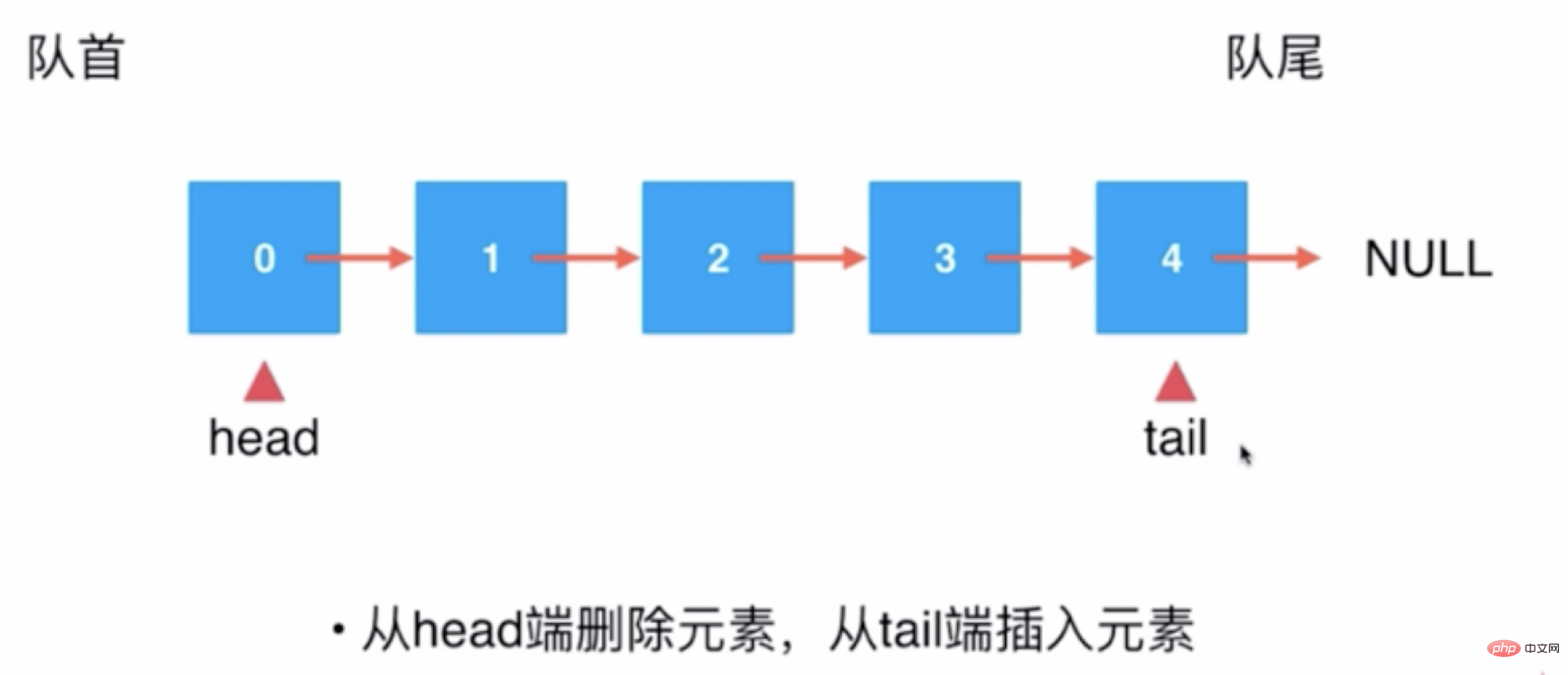
This article will introduce you to the implementation of linked list in PHP. It has certain reference value. Friends in need can refer to it. I hope it will be helpful to everyone.
Recommended study: "PHP Video Tutorial"
A linked list is a non-continuous and non-sequential storage structure on a physical storage unit. The logical order of data elements is achieved through the link order of pointers in the linked list. A linked list consists of a series of nodes (each element in the linked list is called a node), and nodes can be dynamically generated at runtime.
Forms: single linked list, double linked list, skip list (the redis collection data structure is realized by skip list, time complexity O (log N))
Learn about skip list: https://lotabout .me/2018/skip-list/
Define node class:
<?php class Node
{
public $val;
public $next;
public function __construct( $val = null, $next = null )
{
$this->val = $val;
$this->next = $next;
}
}Linked list class:
<?php /**链表
* Class Linklist
* @package app\models
*/
class Linklist
{
public $head; //头节点(默认一个虚拟头节点)
public $size; //长度
public function __construct()
{
$this->head = new Node();
$this->size = 0;
}
//头插法
public function addFirst( $value ){
// $node = new Node($value);
// $node->next = $this->head;
// $this->head = $node;
//简化
// $this->head = new Node( $value, $this->head );
// $this->size++;
$this->add(0,$value);
}
/**指定索引位置插入
* @param $index
* @param $value
* @throws Exception
*/
public function add( $index, $value ){
if( $index > $this->size )
throw new Exception('超过链表范围');
// if( $index==0 ){
// $this->addFirst($value);
// }else{
$prev = $this->head;
for($i=0;$inext;
}
// $node = new Node($value);
// $node->next = $prev->next;
// $prev->next = $node;
$prev->next = new Node($value,$prev->next);
// }
$this->size++;
}
/**尾插法
* @param $value
*/
public function addLast( $value ){
$this->add($this->size,$value);
}
/***
* 编辑
* @param $index
* @param $value
* @throws Exception
*/
public function edit( $index, $value ){
if( $index > $this->size-1 )
throw new Exception('超过链表范围');
$prev = $this->head->next;
for($i=0;$ival = $value;
$prev = $prev->next;
}
}
/**
* 查询
* @param $index
* @return null
* @throws Exception
*/
public function select($index){
if( $index > $this->size-1 )
throw new Exception('超过链表范围');
$prev = $this->head->next;
for($i=0;$inext;
}
}
/**删除
* @param $index
* @throws Exceptionr
*/
public function delete( $index ){
if( $index > $this->size-1 )
throw new Exception('超过链表范围');
$prev = $this->head;
for($i=0;$inext = $prev->next->next;
$prev = $prev->next;
}
$this->size--;
}
/**检索值是否存在
* @param $value
* @return bool
*/
public function iscontain( $value ){
$prev = $this->head->next;
while( $prev ){
if( $prev->val==$value ){
return true;
}
$prev = $prev->next;
}
return false;
}
/**转换为字符串
* @return string
*/
public function tostring(){
$prev = $this->head->next;
$r = [];
while( $prev ){
$r[] = $prev->val;
$prev = $prev->next;
}
return implode('->',$r);
}
/**
* 删除指定的节点值
* @param $value
*/
public function removeFileds( $value ){
$prev = $this->head;
while( $prev->next ){
if( $prev->val == $value ){
$prev->val = $prev->next->val;
$prev->next = $prev->next->next;
}else{
$prev = $prev->next;
}
}
}
/**
* 通过递归方式删除指定的节点值
* @param $value
*/
public function removeFiledsByRecursion( $value ){
$this->head = $this->removeByRecursion( $this->head ,$value);
return $this->head;
}
public function removeByRecursion( $node , $value, $level=0 ){
if( $node->next == null ){
$this->showDeeep($level,$node->val);
return $node->val == $value ? $node->next:$node;
}
$this->showDeeep($level,$node->val);
$node->next = $this->removeByRecursion( $node->next,$value,++$level );
$this->showDeeep($level,$node->val);
return $node->val == $value ? $node->next:$node;
}
/**
* 显示深度
* 帮助理解递归执行过程,回调函数执行层序遵循系统栈
* @param int $level 深度层级
* @param $val
* @return bool
*/
public function showDeeep( $level=1,$val ){
if( $level<p>The calling operation is as follows: </p><pre class="brush:php;toolbar:false"><?php $node = new Linklist();
$node->addFirst(1);
$node->add(1,7);
$node->add(2,10);
$node->edit(1,8);
var_dump($node->select(1)) ;
$node->delete(1);
$node->addLast(99);
var_dump($node->iscontain(2));
var_export($node);
var_export($node->tostring());Analyze the time complexity of the linked list operation:
增: O(n) 只对链表头操作:O(1) 删: O(n) 只对链表头操作:O(1) 改:O(n) 查:O(n) 只对链表头操作:O(1)
<?php /**
* 链表实现栈
* Class LinklistStack
* @package app\models
*/
class LinklistStack extends Linklist
{
/**
* @param $value
*/
public function push( $value ){
$this->addFirst($value);
}
/**
* @return mixed
*/
public function pop(){
$r = $this->head->next->val;
$this->delete(0);
return $r;
}
}<?php $stack = new LinklistStack();
$stack->push(1);
$stack->push(3);
$stack->push(6);
$stack->push(9);
print_r($stack->pop());
print_r($stack->head);
<?php /**
* 链表实现队列
* Class LinkListQueue
* @package app\models
*/
class LinkListQueue extends Linklist
{
public $tail; //尾节点
/**
* push
* @param $value
*/
public function push( $value ){
if( $this->head->val==null ){
$this->tail = new Node( $value );
$this->head = $this->tail;
}else{
$this->tail->next = new Node( $value );
$this->tail = $this->tail->next;
}
$this->size++;
}
/**
* pop
* @return null
* @throws \Exception
*/
public function pop(){
if( $this->sizehead->val;
$this->head = $this->head->next;
$this->size--;
return $val;
}
/**
* 查看队首
*/
public function checkHead(){
return $this->head->val;
}
/**
* 查看队尾
*/
public function checkEnd(){
return $this->tail->val;
}
/**
* toString
*/
public function toString(){
$r = [];
while( $this->head ){
$r[] = $this->head->val;
$this->head = $this->head->next;
}
return implode('->',$r);
}
}Test
<?php $stack = new LinkListQueue();
$stack->push(1);
$stack->push(3);
$stack->push(6);
$stack->push(9);
print_r($stack->pop());
print_r($stack->head);
print_r($stack->checkHead());
print_r($stack->checkEnd());
print_r($stack->toString());
/**
1
app\models\Node Object
(
[val] => 3
[next] => app\models\Node Object
(
[val] => 6
[next] => app\models\Node Object
(
[val] => 9
[next] =>
)
)
)
3
9
3->6->9
**/The above is the detailed content of Detailed explanation of how to implement linked list in PHP. For more information, please follow other related articles on the PHP Chinese website!




